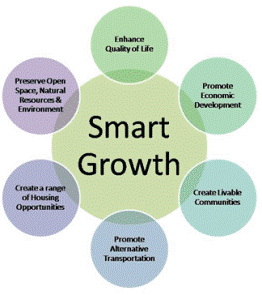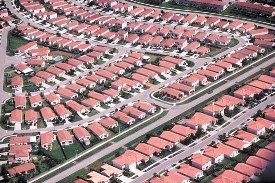Californians like sprawl far more than ‘smart growth’
by CalWatchdog Staff | June 25, 2013 6:15 am
June 25, 2013
By Chris Reed
 California’s official embrace of trendy “smart growth” — the policy/religion that assumes it’s best for individuals, communities and Gaia for most people to live in densely packed areas near transportation hubs, so they don’t use devil fossil-fuel cars — was formalized in 2008 with the enactment of SB 375.
California’s official embrace of trendy “smart growth” — the policy/religion that assumes it’s best for individuals, communities and Gaia for most people to live in densely packed areas near transportation hubs, so they don’t use devil fossil-fuel cars — was formalized in 2008 with the enactment of SB 375.
Sen. Darrell Steinberg’s brainchild was, of course, reflexively embraced by the L.A. Times’ George Skelton[1]:
The glory that is (not) ‘compact development’
“The measure (SB 375) links regional planning for housing and transportation with California’s new greenhouse gas reduction goal (AB 32) enacted in 2006. …
‘If people are going to drive — and they are going to drive — we need to plan in ways to get them out of their cars faster. That means shrinking — not the amount of housing, not economic development, not growth — but shrinking the footprint on which that growth occurs.’
“Steinberg wants it to occur within a smaller circle around downtown.
“Basically the bill would work like this: Each metropolitan region would adopt a ‘sustainable community strategy’ to encourage compact development. They’d mesh it with greenhouse emissions targets set by the California Air Resources Board, which is charged with commanding the state’s fight against global warming.
“And this is the key part: Transportation projects that were part of the community plan would get first dibs on the annual $5 billion in transportation money disbursed by Sacramento.”
Greens: no more growth ‘in the wrong location’
“‘It’s a watershed moment for the environmental community,’ Tom Adams, board president of the California League of Conservation Voters, told the Assembly Local Government Committee on Tuesday as the panel approved the bill. ‘We realized we had to encourage growth, but growth in the right location. Otherwise, we’d get growth anyway, but in the wrong location.’
“Adams calls the measure ‘the most important land-use bill in California since enactment of the Coastal Act’ three decades ago.”
Five years later, the “smart growth” dream has never been realized in California. There are still seminars and press releases[2] and politicians who promise that change is a-coming. Those behind the hype just can’t offer many concrete examples.
Why? The public just isn’t that into “compact development” and prefers to live in the “wrong location.” Even the powerful incentives that SB 375 provides can’t change this fundamental dynamic.
This is from a recent commentary[3] by Chapman University’s wonderful futurist Joel Kotkin that looked at America’s fastest-growing cities since the recession.
“It was widely reported that the Great Recession and subsequent economic malaise changed the geography of America. Suburbs, particularly in the Sun Belt,, were becoming the ‘new slums’ as people flocked back to dense core cities.
“Yet an analysis of post-2007 population trends by demographer Wendell Cox in the 111 U.S. metro areas with more than 200,000 residents reveals something both very different from the conventional wisdom and at the same time very familiar. Virtually all of the 20 that have added the most residents from 2007 to 2012 are in the Old Confederacy, the Intermountain West and suburbs of larger cities, notably in California. … growth is still fastest in the Sun Belt, in suburban cities and lower-density, spread out municipalities. …
“Nothing in the data … suggests a revival of the older, dense “legacy” cities that were typical of the late 19th century and pre-war era. Most of the fastest-growing big cities since 2007 are of the sprawling post-1945 Sun Belt variety … .
Suburban sprawl routs unpopular, dumb ‘smart growth’
 The anti-smart growth pattern was particularly notable in California, Kotkin writes.
The anti-smart growth pattern was particularly notable in California, Kotkin writes.
“The other somewhat surprising result is the strong performance of more purely suburban cities, that is, ones that have grown up since car ownership became nearly universal. They are not the historic cores of their regions but have developed into major employment centers with housing primarily made up of single-family residences. These include the city that has grown the second most in the U.S. since 2007: Chula Vista, a San Diego suburb close to the Mexican border, whose population expanded 17.7%. It’s followed in third place by the Los Angeles suburb of Irvine (16.3%); No. 7 Irving, Texas; and the California cities of Fremont (13th) , located just east of San Jose-Silicon Valley, and Oxnard (17th), north of Los Angeles.
“… Americans continue to move decisively to both lower-density, job-creating cities and to those less dense areas of major metropolitan areas particularly where single-family houses, good schools and jobs are plentiful. …
“Migration numbers for 2010 to 2012 alone hammer home that suburban areas are continuing to attract people, and that the more dense core areas do not generally perform as well. Although their growth has slowed compared to the last decade, suburban locales, with roughly three-quarters of all residents of metropolitan areas, have added many more people than their core counterparts. …
“The urban future will continue to evolve in directions that contradict the prevailing conventional wisdom of a shift toward more crowded living.”
Bad news for Darrell Steinberg and the other Stalinist planners who want to dictate where and how we live. Good news for those who believe in the American dream of a single-family home with a car or two in the sprawl that green schemers so hate.
- L.A. Times’ George Skelton: http://articles.latimes.com/2008/aug/21/local/me-cap21
- seminars and press releases: http://www.smartgrowthcalifornia.org/
- recent commentary: http://www.joelkotkin.com/content/00764-americas-fastest-growing-cities-recession
Source URL: https://calwatchdog.com/2013/06/25/smart-growth-still-a-flop-with-broad-ca-public/